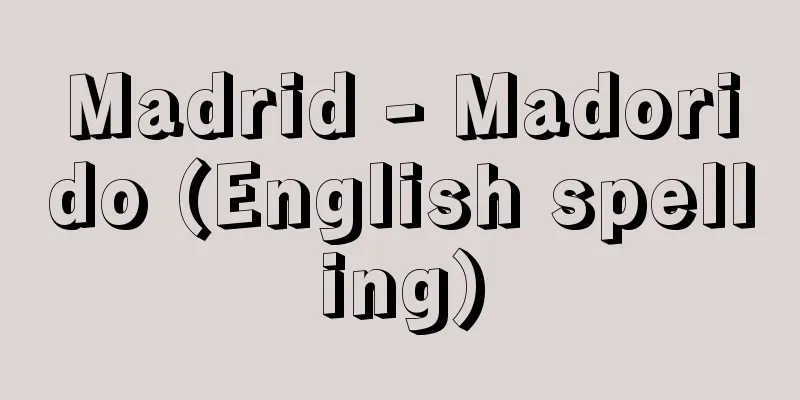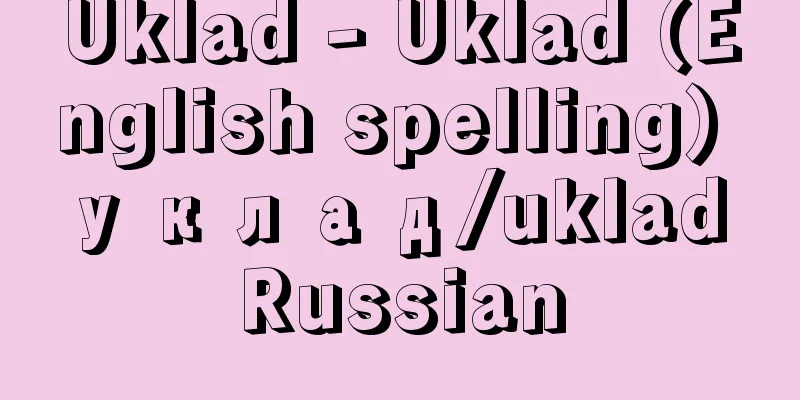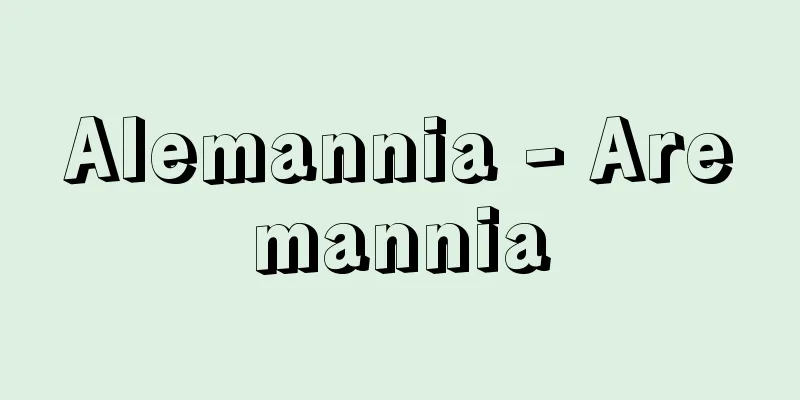Madrid - Madorido (English spelling)

|
The capital of Spain. Located almost in the center of the country, it is the key to the road, rail and air networks, as well as the political and economic center, the seat of the archbishopric and the university. Its population of 2,938,723 (2001) is the largest in Spain. The Greater Madrid Metropolitan Area (Greater Madrid), including the surrounding municipalities, is home to a little over 10% of the total population of Spain. The autonomous community is centered around Greater Madrid, with an area of 7,995 square kilometers and a population of 5,423,384 (2001). It is located on the Meseta at an altitude of 655 meters at the southern foot of the Guadarrama Mountains, making it the highest capital city in Europe. As it is located on a plateau and inland, it has an inland climate, with daily temperature ranges of up to 11 degrees Celsius. The average temperature is 4.9 degrees Celsius in January and 24.2 degrees Celsius in August, but there are days when it is close to 40 degrees Celsius in summer and below -10 degrees Celsius in winter. The annual rainfall is 438 mm, with most rain in spring and autumn and little rain in summer. The city center was the Parque del Morro and the Royal Palace on the left bank of the Manzanares River, and the area to the east of them, which constituted the city area until the mid-19th century. This old town was small, less than 10% of the current city area, and had a population of about 180,000 at the time, and was simply a town with a royal palace. The city expanded around the time of the opening of the railway in the second half of the 19th century, when residential areas, factories, and transportation facilities were built. In particular, after the Spanish Civil War (1936-39), the population increased significantly due to the concentration of a huge number of bureaucrats following the birth of a powerful centralized state, and the influx of a large number of construction workers for reconstruction. Furthermore, factories and offices concentrated in the area, seeking abundant labor, a large market, and connections with the central government, which held various licensing powers, and the tertiary industry also developed. As a result, the population grew rapidly, from 950,000 in 1930, to 1.62 million in 1950, and 3.1 million in 1970, and the city area expanded; the university city in the northwest, El Retiro Park in the east, and Oeste Park in the west, which were once located nearby, were all incorporated into the city limits, and the large park of Casa de Campo in the west suburbs now borders the city center, separated by the Manzanares River. Until the 19th century, the main industries in the city were tapestry wall hangings and porcelain manufacturing, made by artisans employed by the royal family, but today there are a variety of industries, including mechanical industries producing automobiles, motorcycles, aircraft, and electrical machinery, chemical industries producing rubber, plastics, and medicines, and paper, leather, furniture, publishing, and printing. Industrial areas have also been formed in the suburbs and surrounding areas, and satellite cities have also been established. This rapid expansion of the city and concentration of population has led to urban problems such as a housing shortage, underdeveloped transportation systems, difficulty finding parking in the old town, and air pollution. The old town is home to the Royal Palace, the egg-shaped square called Puerta del Sol (Gate of the Sun), which is the starting point of the main road, the Plaza Mayor, which was built as an open-air theater in the 1600s and is surrounded by buildings with balconies, and the Prado Museum, one of the world's leading art museums, attracting many tourists. The San Isidro Festival in mid-May is particularly grand and lively. [Yutaka Tanabe and Yumiko Takizawa] historyIt began in the 9th century when Mohammed I of the Umayyad dynasty built a fortress here, and King Alfonso VI of Castile and Leon recaptured it in 1083. It became a base for the Reconquista (war of recovery of the country), and in the 13th century the king granted it city privileges. Its importance gradually increased, with the Cortes (royal parliament) being held here in 1339, but it did not become the center of the kingdom until the 15th century, when the Cortes began to be held frequently and a royal palace was established. After the unification of Spain through the union of the Kingdom of Castile and the Kingdom of Aragon (1469), the court was moved here from Toledo during the reign of Philip II, and it literally established its position as the central city of Spain. During the War of Spanish Succession that began in 1701, it was occupied by Archduke Charles of the Habsburgs from 1706 to 1710, but it consistently supported Philip V of the Bourbons. Not only was it a political city, but during the Enlightened Despotism, commerce and industry also developed under Charles III, and the Banco de San Carlos (later the Bank of Spain) was established in 1782. In 1808, a popular uprising against the French occupying forces occurred, but the French army carried out harsh repression, which triggered the War of Independence against France and the National War of guerilla warfare across the country. However, the city remained under French occupation until the war ended in 1814. The success or failure of coups and popular uprisings here played a decisive role in changes of power in the 19th century. Examples include the ouster of Regent Maria Cristina in 1840 due to a popular uprising, and the birth of a progressive government in 1854, which was triggered by the declaration of a coup in the nearby town of Vicálvaro and the response of the people. Its continued position as a central political centre even into the 20th century; the failure of a general strike here in October 1934 led to the defeat of the October Revolution, while the failure of a military mutiny in July 1936 and the successful defence of the Republic forced Franco's side to abandon the idea of a short-term battle and necessitated a long civil war. [Jiro Nakatsuka] It was completed in 1764 during the reign of Charles III. It is a neoclassical building, representative of the Bourbon dynasty. Madrid, Spain ©Shogakukan "> Royal Palace of Madrid Surrounded by 17th century buildings, it was once the site of trials and bullfights. The San Isidro festival on May 15th is crowded with many people. Madrid, Spain ©Shogakukan "> Plaza Mayor It is one of the world's largest art museums, established in 1819 as the Royal Museum of Fine Arts by order of King Ferdinand VII. Its collection exceeds 17,000 pieces, more than half of which are Spanish paintings. In front of the museum stands a statue of Velázquez, the master of Spanish painting. Madrid, Spain ©Shogakukan "> Prado National Museum Source: Shogakukan Encyclopedia Nipponica About Encyclopedia Nipponica Information | Legend |
|
スペインの首都。同国のほぼ中央にあり、道路、鉄道、航空網の要(かなめ)であるとともに、政治、経済の中心地で、大司教座、大学の所在地。人口293万8723(2001)はスペイン第1位。周辺の自治体を含めたマドリード大都市圏(大マドリード)には、スペイン全人口の1割強が集中している。この大マドリードを核として自治州を構成し、その面積は7995平方キロメートル、人口542万3384(2001)。グアダラマ山脈南麓(なんろく)の標高655メートルのメセタ上に位置し、ヨーロッパの首都としては最高所にある。高原で、かつ内陸に位置するため気候は内陸性を示し、とくに気温の日較差は11℃に達することがある。平均気温は1月4.9℃、8月24.2℃であるが、夏は40℃近くに、冬は零下10℃以下になる日もある。年降水量は438ミリメートルで、春・秋に雨が多く、夏は少雨で乾燥している。 市街地の中心部は、マンサナーレス川左岸の岸辺にあるモーロ公園と王宮およびその東側で、19世紀中ごろまでの市域である。この旧市街は現在の市域の1割にもあたらない狭い範囲であり、当時の人口は18万程度で、単に王宮のある町にすぎなかった。市街地の拡大は19世紀後半の鉄道開通と前後して、住宅地、工場、交通施設が建設されてからである。とくにスペイン内戦(1936~39)後、強大な中央集権国家の誕生に伴う膨大な官僚群の集中と、復興のための建設労働者の大量流入により著しい人口増加が起こった。さらに豊富な労働力と大きな市場、さまざまな許認可権を握る中央政府との結び付きを求めて工場や事務所群が集中し、第三次産業も発展した。その結果、人口は1930年95万、1950年162万、1970年310万と急速に増加し、市域が拡大、かつては近郊にあった北西部の大学都市や東部のエル・レティロ公園、西のオエステ公園は市域内に取り込まれ、西郊のカサ・デ・カンポの大公園も、現在はマンサナーレス川を挟んで市街地に接している。 産業としては、19世紀までは王室お抱えの職人による綴織(つづれおり)の壁掛けや磁器製造などがおもなものであったが、現在は自動車、オートバイ、航空機、電気機械などの機械工業、ゴム、プラスチック、薬などの化学工業、製紙、皮革、家具、出版、印刷などの諸工業が立地している。工業地域はさらに郊外や周辺に形成され、衛星都市もできている。このような急速な都市の拡大と人口の集中は、住宅不足、交通機関の整備の立ち遅れ、旧市街における駐車場難、大気汚染等々の都市問題を引き起こしている。 旧市街には王宮、主要幹線道路の起点となっている「プエルタ・デル・ソル」(太陽の門)とよばれる卵形の広場、1600年代に野外劇場としてつくられ、バルコニーのついた建物に囲まれているマヨール広場、世界有数の美術館プラド美術館などがあり、多くの観光客を集めている。とくに5月中旬のサン・イシドロの祭りは盛大でにぎわう。 [田辺 裕・滝沢由美子] 歴史9世紀にイスラム・ウマイヤ朝のムハンマド1世がここに城砦(じょうさい)を築いたことに始まり、カスティーリャ・レオン王アルフォンソ6世が1083年に奪回した。以後レコンキスタ(国土回復戦争)の拠点となり、13世紀には国王から都市特権を与えられた。1339年にここでコルテス(王国議会)が開かれるなど徐々に重要性を増していったが、王国の中心となり始めるのは、コルテスがたびたび開催されるようになり王宮も据えられる15世紀である。カスティーリャ王国とアラゴン王国の合同(1469)によるスペインの統一以後、フェリペ2世の時代に宮廷がトレドからここに移されてからは、文字どおりスペインの中心都市としての地位を確立する。1701年に始まったスペイン継承戦争では、1706年から1710年までハプスブルク家カール大公に占領されたが、一貫してブルボン家フェリペ5世を支持した。政治都市としてばかりではなく、啓蒙(けいもう)専制時代、カルロス3世のもとで商工業も発展し、1782年にサン・カルロス銀行(後のスペイン銀行)が設立された。 1808年フランス占領軍に対する民衆蜂起(ほうき)が起こったが、フランス軍が過酷な弾圧を行い、そのためこれを契機に全土で対フランス独立戦争、ゲリラ戦による国民戦争が始まった。しかし、ここは、戦争が終結する1814年までフランスの占領下に置かれた。19世紀における政権交替では、ここでのクーデター、民衆蜂起の成否が決定的な役割を果たす。1840年の民衆蜂起による摂政(せっしょう)マリア・クリスティナの追放、1854年近郊の町ビカルバロでのクーデター宣言と民衆の呼応による進歩派政権の誕生などである。 政治の中心であったことは、20世紀に入ってからも変わらず、1934年10月のここでのゼネスト失敗は十月革命を敗北に導き、1936年7月の軍反乱の失敗、共和国側の防衛成功は、フランコ側に短期決戦を断念させ、長期の内乱を余儀なくさせた。 [中塚次郎] カルロス3世時代の1764年に完成した。ネオ・クラシック様式で、ブルボン王朝時代の代表的建築である。スペイン マドリード©Shogakukan"> マドリードの王宮 17世紀の建物で囲まれ、かつては裁判、闘牛なども行われた。5月15日のサン・イシドロの祭りは多くの人でにぎわう。スペイン マドリード©Shogakukan"> マヨール広場 1819年、フェルナンド7世の命により王立美術館として発足した世界最大級の美術館。収蔵品は1万7000点を超え、その半分以上をスペイン絵画が占める。美術館正面にはスペイン絵画の巨匠ベラスケスの像が建つ。スペイン マドリード©Shogakukan"> プラド美術館 出典 小学館 日本大百科全書(ニッポニカ)日本大百科全書(ニッポニカ)について 情報 | 凡例 |
Recommend
Tateyamakinbai (Tateyama Golden Plum) - Tateyamakinbai (English name) Sibbaldia procumbens L.
An alpine plant of the rose family with yellow flo...
Inari doll - Inari doll
...These styles have been passed down throughout ...
Leopold von Wiese
German sociologist. He started out researching ec...
Financial accounting
Accounting aimed at financial reporting to a comp...
"Emperor Antoku Painting" - Antokutennoue
…It became popular during the Kamakura period, an...
Yamaai - Yamaai
An evergreen perennial plant of the Euphorbiaceae ...
Sergel, Johan Tobias
Born: August 28, 1740 / September 8, 1740, Stockho...
Oyashio Current
A typical cold current in the North Pacific Ocean...
Huang style - I want to do this
A style of painting for Chinese bird-and-flower p...
Medicine grinder - Yagen
A tool for grinding herbal medicines into powder....
Indokiai - Indokiai
…an annual plant of the Polygonaceae family culti...
Gorkhā (English spelling) Gorkha
...the common name of the political force that es...
Kasadandan - Kasadandan
...As the second most important style of zapo, fo...
"Kyochushu" - Kyochushu
…Among them, the “Shuling-Jing” is particularly f...
Irumeya - Irumeya
…Many of his prophecies are in poetic form and ar...









